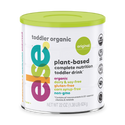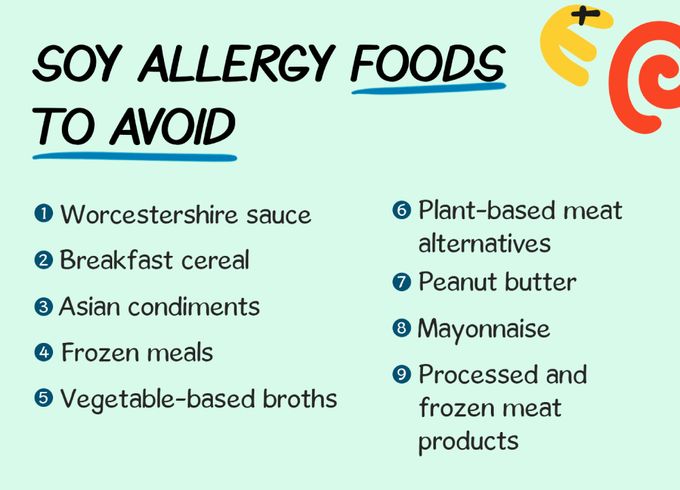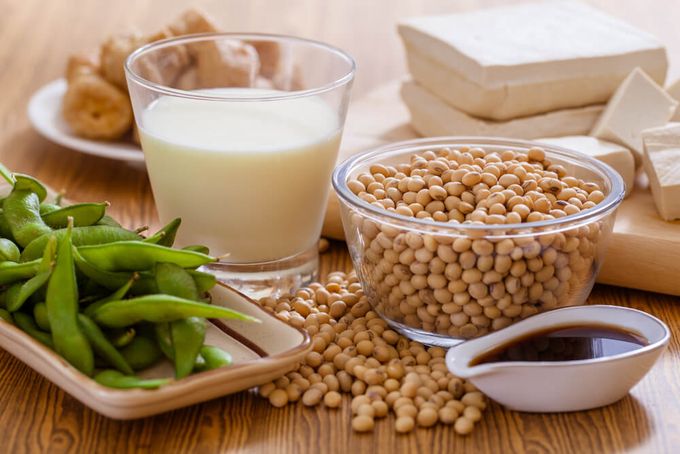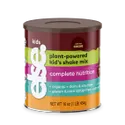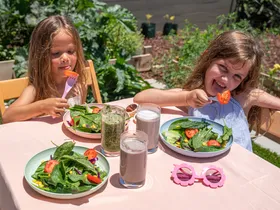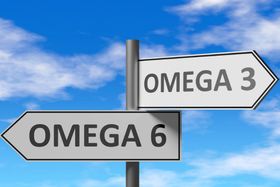Soy Allergy in Children: Foods to Avoid
Discover how to manage a soy-free diet for healthy growth and explore delicious and nutritious alternatives your little ones will adore
Updated July 25, 2024
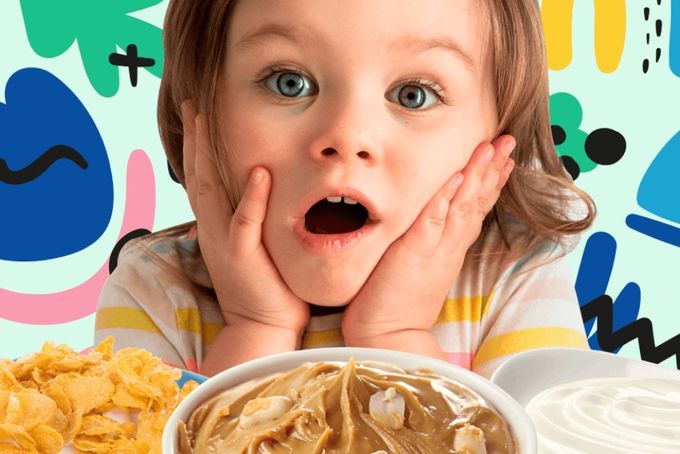
Soy is one of the top eight food allergens, affecting many children and adults. If you’re concerned that your child may have an allergy to soy, it’s important to be aware of which foods contain soy products and how to design a soy-free diet. Understanding the potential signs of a soy allergy and how to minimize exposure can help your child remain as symptom-free as possible.
» Discover soy-free, plant-powered nutrition for healthy growth
What are the symptoms of soy allergy and intolerance?
It’s important to differentiate between soy intolerance symptoms in kids or soy sensitivity and a true soy allergy. In order to determine which one your child has, it’s best to speak with their pediatrician for proper testing. That being said, below are some of the main differences and symptoms of both that may appear.
» Understand if soy-free formula is good for babies
Soy allergy
A soy allergy is when the immune system mistakenly sees soy proteins as foreign invaders in the body and creates immunoglobulin E, or IgE antibodies, to defend itself against them. Once these antibodies are made, the body recognizes whenever soy proteins enter the body and releases histamines in response. In other words, every time soy is consumed, the immune system initiates its attack response. This is what results in the symptoms of an allergic reaction.
Soy allergy reactions may have systemic effects on the skin, heart, digestive tract, or respiratory tract. It may cause symptoms like fussiness and diarrhea in infants, or even vomiting and hives in kids who are a bit older. Other potential symptoms include coughing, shortness of breath, wheezing, a weak pulse, or pale skin.
» Here's what you need to know when choosing dairy and soy-free formula
In rare but severe cases, people with soy allergies may go into anaphylactic shock. This reaction is potentially life-threatening because it impairs breathing, can cause a severe drop in blood pressure, and may result in shock. Children with a severe soy allergy will likely be prescribed an epi-pen or a dose of injectable epinephrine that can be administered to stop an allergic reaction in the event of an emergency.
» Discover reasons you should opt for soy-free baby formula
Soy intolerance or sensitivity
An intolerance or soy sensitivity, on the other hand, is not an immune response. Intolerance is generally less severe and often results in symptoms that mainly affect the digestive system, like nausea, abdominal cramping, and diarrhea. Still, people with a soy intolerance may initially react to soy in a similar way as a soy allergy, which can make it very difficult to differentiate between the two without an expert opinion.
Negative reactions to soy can appear either immediately after your child consumes it or hours after - similar to signs of lactose intolerance in kids. If you’re trying to determine if your child is having a reaction to soy foods, it can be helpful to keep a food journal that records the type and timing of symptoms as well as the food consumed.
» Here's what you should look for in soy-free formula
How common is a soy allergy?
Soy is one of the top eight food allergens, which make up over 90% of all food allergies. The other allergens in this group include cow’s milk, fish, shellfish, wheat, tree nuts, peanuts, and eggs.
An allergy to soy commonly begins early on in infancy or toddlerhood. Only a small amount (an estimated 15%) of babies who have cow’s milk allergies are also allergic to soy. While many children will continue to experience a soy allergy for life, others may outgrow it around age ten. Read through our guide on treating toddler seasonal allergies to see if that can be a factor as well.
» Boost your kid's immunity through nutrition to effectively manage soy allergy
Interestingly, it’s uncommon for an individual to be allergic to soy and nothing else. In other words, if your child has a soy allergy, it’s possible that they may have an allergy to other foods or ingredients. This may be worth exploring, particularly if you have a family history of food allergies.
Note that the biggest way in which having a soy allergy may impact a child’s health is because of the risk of being exposed to soy through so many foods and other consumer products. While soy is an excellent source of protein and other nutrients, there are plenty of other foods to help make sure that your child receives a healthy and adequate diet.
How do you test for a soy allergy?
It’s best for your pediatrician to help you navigate diagnostic testing for a soy allergy, which is most often conducted in conjunction with an allergist. Some of the most commonly used tests to identify and confirm food allergies, like a soy allergy, include the intradermal skin test, skin prick test, radioallergosorbent test (RAST), food challenge, and elimination diet.
How to test for a soy allergy at home
It’s not recommended to intentionally test for food allergens at home due to the potentially life-threatening nature of food allergies among some children. Food allergies can range in their severity and should be treated with caution, especially when you’re uncertain whether your child has one. Testing for a food allergy should be done under the direct supervision of an expert clinician, as discussed above.
» Explore soy-free solutions to fuel your child's growth
Which foods contain soy?
Soy can be a difficult ingredient to avoid for people who are allergic to it. This is because, while whole soy foods are more obvious and easier to avoid, processed soy and soy-derived ingredients are used in a wide variety of packaged foods.
Soy foods in their whole or minimally processed form include tofu, tempeh, natto, miso edamame, and soy milk. More processed soy foods may include other traditionally dairy-based foods made with soy, such as ice cream, yogurt, cheese, butter, sour cream, and certain dressings or condiments.
» Try a healthy and delicious soy-free nutrition for sensitive stomachs
One example of a common soy-derived ingredient is soy lecithin. This is a food additive found in many packaged food items. It serves as an emulsifying agent, which helps increase the shelf life of some products, prevents the spattering of certain foods when heated in oil, and prevents chocolate candy from crystallizing. Still, it doesn’t generally contain enough of the soy protein that causes allergies in people, so it’s possible that this may not be a trigger for your child, even if they have a soy allergy.
The bottom line here is that, in addition to whole soy foods, many packaged and processed foods may contain soy in the form of food additives.
» Discover the benefits of offering whole foods to babies and toddlers
Soy allergy foods to avoid
If a child is allergic to soy, it’s important to be aware of which foods to avoid that may be common in many households. Having a soy allergy foods to avoid list can be helpful—you can place it on your refrigerator or take it with you to the grocery store until you get the hang of shopping soy-free.
Fortunately, there is a law called the Food Allergen Labeling and Consumer Protection Act (FALCPA) that requires that packaged foods in the United States have a statement on them clearly indicating they may contain soy or an ingredient that contains soy.
» Introduce a delicious, soy and dairy-free alternative to your child's diet
But because soy is so commonly used as an ingredient, it’s frequently found in packaged foods such as:
- Peanut butter
- Breakfast cereal
- Asian condiments
- Mayonnaise
- Worcestershire sauce
- Vegetable-based broths
- Plant-based meat alternatives (e.g., deli slices, hot dogs, burgers)
- Frozen meals
- Processed and frozen meat products
» If your little ones are on a soy-free diet, make sure they get nutrient-dense foods for healthy weight gain
The best way to avoid soy in common foods is to read the ingredient list on packages and containers.
Soy used as a food additive ingredient may be listed as a number of things on packaged foods. For example, it’s probably best to avoid foods that contain any of the ingredients listed below if your child has a soy allergy:
- Hydrolyzed soy protein
- Tamari
- Textured vegetable protein (TVP)
- Soy fiber
- Soy flour
- Soy yogurt
- Soy albumin
- Soy milk
- Soy curl
- Soy curd
- Soy granules
- Soy sprouts
- Soy protein isolate
- Soy protein concentrate
- Soy sauce
» Here's how to create a balanced diet for your kids
Have you ever noticed that packaged foods often contain “natural flavorings” listed on the ingredients list? This is very common and unfortunately, it’s impossible to know what’s included in this unless you contact the manufacturer directly. If you choose to do so, you should ask them whether soy was used as a carrier protein to make their natural flavorings. While they likely won’t tell you what’s in their natural flavoring, they should be able to answer this simple question.
You may also want to contact a company directly if they have vegetable broths, gums, or starches listed on their product, as these may contain soy.
Furthermore, foods that don’t intentionally contain soy can still come with the risk of having been cross-contaminated with soy during their processing. Many manufacturers choose to include warning statements on products, such as "processed in a facility that also processed soy” or indicating that the product could contain common food allergens by accident. However, these statements are voluntary, so it’s best to choose foods that are at the lowest risk of containing soy in the first place.
» Choosing the right soy-free baby formula eliminates the risk of cross-contamination
Soy-free foods list
Now that you know some of the major foods to avoid with a soy allergy, it can also be incredibly helpful to have a list of foods that are generally soy-free. It’s still a good practice to read ingredient labels in these instances to make sure they are truly soy-free, as that’s the only way to know for sure.
First, if you have an infant who is diagnosed with a soy allergy and is formula-fed, it’s appropriate to choose a soy-free formula, such as a hypoallergenic option. These types of baby formulas contain proteins that have been extensively broken down so that they present a lower risk of triggering an allergic reaction. Elemental infant formulas contain proteins in their simplest, most digestible, and least risky forms when it comes to allergic triggers.
» Prioritize high-fiber, soy-free foods for a balanced, nutritious kids' diet
For older babies and children who are eating solid foods, here are some soy-free staple foods to consider when planning their diet.
Soy-free foods
Breads and starch foods:
- Breads, cereals, and baked goods that don’t contain soy in the ingredients list
- Snacks that don’t contain soy or are cooked in soy oil
- Plain pasta made from wheat, lentils, or beans that are not soy-based
Plant-based milk, cheeses, and dairy products made from:
- Coconut
- Rice
- Hemp
- Almond
- Cashew
- Oats
Produce:
- All fresh fruits and vegetables that are not soybeans
- All frozen plain fruits and vegetables that are not edamame or soybeans
- All canned fruits and vegetables that are not soybeans or contain soy on the ingredients list
Protein and meat substitutes:
- Seitan
- Other meat analogs that are not tofu, tempeh, and don’t contain soy on the ingredients list
Fats and oils:
- Nut butters made from peanuts, cashews, almonds, or sesame seeds and don’t contain soy on the ingredients list
- Butters and margarines that are soy-free
- Vegetable oils that are soy-free, such as olive, avocado, flax, and coconut
» Explore more about plant-based milk
Remember that even though having a child with a soy allergy can feel overwhelming at first, it won’t always feel that way. Having the right diagnosis is the first step to managing a soy allergy, followed by a plan for practicing a soy-free diet pattern and knowing which foods to avoid. Fortunately, there is a growing variety of soy-free plant-based foods available today that can be an excellent part of your child’s diet.
» Nourish your little one with delicious, whole, plant-based nutrition
Try Else for soy allergies
Else formula has been designed to offer comprehensive nutrition to children who need soy-free options. Else products are formulated with organic almonds, tapioca, and buckwheat, are hypoallergenic, and are completely plant-based.
Not only are Else formulas free from soy, but they’re also free from dairy, gluten, GMOs, and corn syrup, which are often found in other infant and toddler formulas. Whether your child needs a soy-free formula or meal supplement, or you’re just looking for a nutritious plant-based option, Else Nutrition products have been designed with your family in mind.
Having a soy allergy is common, especially among young children. While some kids will grow out of their soy allergy within the first decade of life, that’s not the case for everyone. Properly identifying, testing, and diagnosing a soy allergy is imperative for proper management.
For children with soy allergies, choosing soy-free infant formulas and following a diet that excludes soy is the best approach. Additionally, Else Nutrition products can be a helpful and nutrient-rich addition to your child’s soy-free diet.
» Explore our soy-free baby cereal and toddler formula to ensure your child gets the nutrition they need!
The content and advice provided in this article are for informational purposes only and are not a substitute for medical diagnosis, treatment, or advice for specific medical conditions. Always consult a pediatrician to understand the individual needs of your child.





